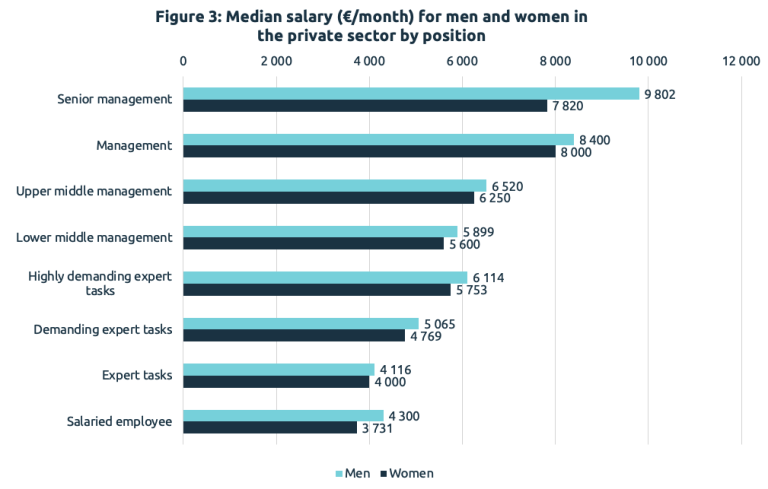A gender pay gap and unexplained gender pay gap
Writer: Tuunia Keränen, Translation: Apropos Lingua
A gender pay gap also exists in the technology sector. According to TEK’s Labour Market Survey, the median monthly salary for women in October 2023 was 5,076 euros and for men 5,665 euros. The average monthly salary for women was 5,379 euros and for men 6,113 euros. The median salary for women was therefore 90% of the median salary for men, while the average salary was 88% of that for men.
The salary figures include respondents who worked full-time, of whom 2,069 were women and 6,347 were men. The number of respondents who had selected the “other/rather not say” option for their gender was so small that their salaries cannot be examined separately.
What causes this difference in pay? Part of the reason is that women and men work in slightly different roles. Figure 1 shows that men are relatively more likely than women to work in management. The proportion of women and men in middle management is roughly equal. A slightly higher proportion of women than men work in expert positions. Salaries are higher in management than in expert jobs, which partly explains the pay gap between men and women.

Figure 2 shows that women are relatively more likely than men to work in the public and university sectors, where salaries are lower than in the private sector. This also explains part of the pay gap.

However, even when looking only at the salaries of men and women working in the private sector and at similar job levels (Figure 3), the median salary for women is still lower than that for men across all levels. The biggest pay gap can be found in senior management and the smallest in expert jobs.

What is the so-called unexplained gender pay gap?
We looked at to what extent the difference in pay between men and women can be explained by various background variables and how much of it is unexplained. We built a statistical model of the pay gap and the factors affecting it. Advice on specific questions related to statistical modelling was obtained from statistician, M.Soc.Sc. Petri Palmu.
The response variable was the monthly salary, and the explanatory variables were, in addition to gender, the following variables: years of experience, position, role, employer’s industry, number of employees, labour market region, degree programme, postgraduate degree and actual weekly working hours. The data was from TEK’s Labour Market Survey 2023.
First, the so-called ‘raw gap’ between men’s and women’s salaries was examined. The study then controlled for the other explanatory variables, leaving the so-called unexplained pay gap. For statistical modelling, the data was trimmed, meaning that some extreme values, such as extremely high salaries, were removed. Because of this, the results differ slightly from the figures presented at the beginning, even though the data was the same.
Various statistical methods were used in the modelling, and statistically significant effects were demonstrated by statistical tests and margins of error. In terms of the experience measure, the coefficients in the model were simulated “back” to the actual response data and into euros.
According to the statistical model, the so-called ‘raw gap’ between men’s and women’s salaries is 9.5%. The gap starts to grow statistically significantly after about 12–13 years of experience. According to the model, the so-called unexplained pay gap after controlling for variables is 5.5%, indicating that segregation explains just under half, or about 43% of the gender pay gap.

Segregation refers to the tendency of men and women to work in different kinds of jobs. As stated at the beginning of this article, women are slightly more likely than men to work in expert jobs and in the public sector, where salaries are lower than in management positions and the private sector. Men are more likely than women to work in management: the statistical model showed that, after controlling for work experience, men are twice as likely as women to work in management positions.
The statistical modelling also showed that women and men tend to work in slightly different industries in the private sector. In addition, women and men pursue different roles and also different degree programmes.
Within the private sector, women are under-represented in industries such as data communication and electronics, where salaries are higher than average. Looking at roles, women are under-represented in sales and marketing positions where salaries are higher than average. Meanwhile, they are over-represented in design, quality management and training roles, where salaries are lower than average. In terms of degree programmes, women are more likely than men to have graduated in fields such as architecture, environmental engineering and materials science, where salaries are lower than average.
However, even after all this is taken into account, there still remains an unexplained pay gap of 5.5%. The gender pay gap has also been examined using data from the Labour Market Surveys in 2016, 2013 and 2010. In these years, the so-called unexplained pay gap was also around 5%. In 2008, 2007 and 2003, the gap was around 6%. The 2003 Labour Market Survey revealed that the gap had narrowed by just under one percentage point from the years 1996 and 2000. The pay schemes for different years are not fully comparable, but it can still be argued that, although progress in closing the pay gap has been slowly made, it has stalled in recent years.
These results concern the gap in monthly salary. Over the course of a year, this gap adds up to a substantial sum, let alone over several years or whole careers. Earnings over your career affect the amount of pension you receive, for example.
Example calculations of the unexplained pay gap at different pay levels
- For a monthly salary of 5,665 euros (median salary for men), the unexplained pay gap per month is around 312 euros. This amounts to 3,895 euros per year.
- For a monthly salary of 5,065 euros (median salary for men in demanding expert jobs in the private sector), the unexplained pay gap per month is around 279 euros. This amounts to 3,482 euros per year.
- For a monthly salary of 6,520 euros (median salary for men in upper middle management in the private sector), the unexplained pay gap per month is around 359 euros. This amounts to 4,483 euros per year.
- For a monthly salary of 8,400 euros (median salary for men in management positions in the private sector), the unexplained pay gap per month is around 462 euros. This amounts to 5,775 euros per year.
These calculations are examples and assume that the unexplained pay gap is the same across all job levels. The annual salary has been calculated by multiplying the monthly salary by 12.5, i.e. including the holiday bonus.
Equal pay in tech – much talk, but little action?
Writer: Sirkku Pohja, Translation: Apropos Lingua
Long-term data shows that for almost 30 years, the gender pay gap in the technology sector has remained almost stagnant. Progress towards equality in working life and equal pay is slow in Finland, in the other Nordic countries and across all fields of work. The reasons for this slow progress are at least outdated attitudes, working cultures, poor equality awareness and a lack of concrete actions to promote equality.
For the past 15 years or so, we at TEK have been raising the issues of pay and fair pay, and equality and equal opportunities in working life. Continuing the debate and producing more research on pay, pay differences and the underlying causes of the gender pay gap is important to our members, according to our surveys.
Equal pay does not mean that all employees are paid the same, but there can and should be differences in pay. However, they should be based on the demands of the job and the employee’s skills and performance. Differences in pay should not be based on gender.
The more gender balance there is in the choice of tech studies, the more likely it is that the technology sector will be more gender balanced in the future.
We want to address the current gender bias in the tech labour market so that all genders are more equally represented at all levels, including in senior positions, such as business management and company boards. This will make it easier to achieve pay equality and allow work to evolve in a more productive direction.
Knowledge facilitates action
We train employee representatives on the principles of equality and equal opportunities at work so that they can address the issue of equal pay whenever their workplace prepares its first equality plan or updates an existing one. Awareness about equal pay is important, for example when conducting a pay survey.
In the bigger picture, we influence labour legislation through our central organisation Akava. In Akava’s working group, we draft and submit proposals e.g. for specifying and revising the equality and non-discrimination legislation, taking into account the needs of work life now and in the future.
When amendments to the law are made regarding equal pay or equality and equal opportunities in general, we announce them in our channels and train employee representatives so that they can promote these issues in their workplace with the people they represent and their employer.
We are also involved in the Equal Pay Programme through Akava. The aim of the Programme is to achieve gender pay equality in society. The measures under the Programme are raising pay awareness; dismantling the gender-based division of labour, i.e. segregation in the labour market; supporting the reconciliation of work and family life; and improving equality planning at workplaces.
Talk about your salary and encourage your colleagues to do the same
Writer: Sirkku Pohja, Translation: Apropos Lingua
Salary advice is our popular membership service, offering a comprehensive range of information, statistics and advice about salaries, and the Salary Surveyor tool. We also provide individual advice on issues such as planning your salary request and desired salary increase, preparing for a salary negotiation and discussion and reporting potential pay discrimination.
We provide guidance on how to talk about your salary, even when you are not hoping for a raise. It is important for everyone to bring up the topic of their pay regularly, at least once a year and whenever the demands of the job increase or they gain more work experience or switch roles. This allows employees to influence their salary development and keep the salary from falling behind, for example.
You should talk about your salary in euros to ensure that the workplace has good pay awareness. When everyone is transparent about their pay, you can compare your salary and duties with others, see what the equality plan at your workplace says about pay and discuss with your shop steward how to maintain and promote pay equality.
Regardless of its size, the workplace must comply with the Act on Equality. Every employer has a legal duty to promote equality in the terms of employment, especially in pay. The more openly pay is discussed at work, the more likely you are to achieve pay equality.
Even though talking about your salary is still considered almost taboo, everyone is allowed to talk about their salary. You may find it difficult at first, but it will get easier as you practice. Equal pay for equal work and work of equal value is fair.
This is a major issue. If the labour market and pay do not become equal, equality will not be achieved in the rest of society either.



